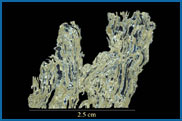The Minerals That Make Up The Lost City Chimneys
 |
|
Thin Section
|
The mineralogy of the chimneys is very simple. The structures are dominantly composed of aragonite (CaCO3) and calcite (CaCO3), with lesser amounts of brucite [Mg(OH)2]. The minerals aragonite, however, is relatively unstable such that it converts to calcite through time. Therefore, the youngest active samples are dominated by aragonite and brucite, while the older samples contain variable mixtures of aragonite, calcite and brucite.
We have cut several of the samples and ground them down so that they are thinner than a sheet of paper. Looking at these “thin sections” of rocks under a microscope, we see that the young samples contain very large holes, or pores, and that long strands of carbonate bound the pore space. The strands are very similar to filamentous strands of bacteria in active sites of diffuse flow, which were observed through the view ports of Alvin. We believe that the microbes serve as sites for the crystals to precipitate. In older samples, it is likely that this well developed pore space serves as a wonderful habitat for microorganisms to grow.